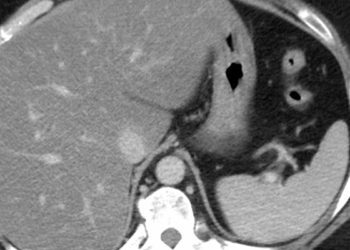Carboplatin during radiotherapy recommended exclusively in pediatric patients with high-risk group 3 medulloblastoma
1. The study suggested that carboplatin during standard radiotherapy should only be recommended in pediatric patients with high-risk group 3 medulloblastoma and not for other molecular subgroups.
2. Further studies to improve risk stratification via molecular diagnosis and the development of novel therapies with less neurocognitive toxic effects in children with high-risk medulloblastoma are warranted to improve overall survival and quality of life.
Evidence Rating Level: 1 (Excellent)
Study Rundown: Medulloblastoma is the most common type of embryonal cancerous brain tumor in children involving the cerebellum. It has a 5-year survival rate of approximately 70% and a worse prognosis if the tumor invades the spinal cord. By using a multimodal approach to therapy, including neurosurgical resection, craniospinal radiation, and combination chemotherapy, medulloblastoma may be cured in most children. However, there are currently few curative options available for individuals that experience relapse following initial multimodal therapy. Thus, the Children’s Oncology Group, an international research collaboration, conducted a randomized clinical trial to evaluate the therapeutic benefits of carboplatin as a radiosensitizer and isotretinoin as a proapoptotic agent in children with high-risk medulloblastoma. Objective evaluation of these therapeutic interventions as well as risk stratification of specific molecular subgroups and signaling pathways were performed to better understand their association with disease progression and help provide evidence for clinical decision-making. The main outcome and measure of the analysis was event-free survival, applying the log-rank test to compare arms. The main biological outcome of the study was molecular subgroup classification by DNA methylation array. Among 261 children enrolled with high-risk medulloblastoma, isotretinoin was not associated with any significant improvements in overall survival. Comparatively, the addition of concurrent carboplatin during radiotherapy improved survival from 54% to 73% exclusively in patients with high-risk group 3 medulloblastoma. These results suggested that carboplatin treatment concurrent to standard radiotherapy should only be recommended in pediatric patients with group 3 medulloblastoma. In addition, further studies to improve risk stratification via molecular diagnosis and the development of novel therapies with less neurocognitive toxic effects in children with high-risk medulloblastoma are warranted. A limitation of this study was that during retrospective central pathologic review, 5% of patients displayed diagnostic inconsistencies with the local institutional pathologic diagnosis and, thus, unnecessarily exposing patients enrolled for anaplasia to craniospinal radiotherapy, a treatment with toxic neurocognitive effects when standard-risk therapy was warranted instead.
Click to read the study in JAMA Oncology
Click to read an accompanying editorial in JAMA Oncology
Relevant Reading: Outcome of children with metastatic medulloblastoma treated with carboplatin during craniospinal radiotherapy: a Children’s Oncology Group phase I/II study
In-Depth [randomized controlled trial]: This phase 3 randomized clinical trial enrolled 261 pediatric patients with newly diagnosed high-risk medulloblastoma in the US, Canada, Australia, and New Zealand (median age, 8.6 years [range, 3.3-21.2]; 183 [70%] male). Data was collected between March 2007 and September 2018 from Children’s Oncology Group institutions with analysis completed in September 2020. High-risk features included metastasis (189 patients [72%]), diffuse anaplasia (58 patients [22%]), and greater than 1.5-cm2 residual disease (14 patients [5%]). For interventions, patients were randomized to receive 36-Gy craniospinal radiation therapy and weekly vincristine with or without daily carboplatin followed by 6 cycles of maintenance chemotherapy with cisplatin, cyclophosphamide, and vincristine with or without 12 cycles of isotretinoin during and following maintenance. Overall, the 5-year event-free survival was 62.9% (95% CI, 55.6%-70.2%) and overall survival was 73.4% (95%CI, 66.7%-80.1%). Importantly, isotretinoin randomization was stopped early due to futility. Five-year event-free survival with vs without carboplatin was 66.4% (95%CI, 56.4%-76.4%) vs 59.2% (95%CI, 48.8%-69.6%) respectively (P = .11). In particular, the survival rate exclusively observed in group 3 medulloblastoma patients was 73.2% (95%CI, 56.9%-89.5%) with carboplatin vs 53.7% (95%CI, 35.3%-72.1%) without (P = .047). Lastly, 5-year overall survival differed by molecular subgroup and signaling pathway (P = .006): WNT pathway activated, 100% (95%CI, 100%-100%); SHH pathway activated, 53.6% (95%CI, 33.0%-74.2%); group 3 medulloblastoma, 73.7% (95%CI, 61.9%-85.5%); and group 4 medulloblastoma, 76.9% (95%CI, 67.3%-86.5%).
Image: PD
©2021 2 Minute Medicine, Inc. All rights reserved. No works may be reproduced without expressed written consent from 2 Minute Medicine, Inc. Inquire about licensing here. No article should be construed as medical advice and is not intended as such by the authors or by 2 Minute Medicine, Inc.



![2MM: AI Roundup- AI Cancer Test, Smarter Hospitals, Faster Drug Discovery, and Mental Health Tech [May 2nd, 2025]](https://www.2minutemedicine.com/wp-content/uploads/2025/05/Untitled-design-350x250.png)



